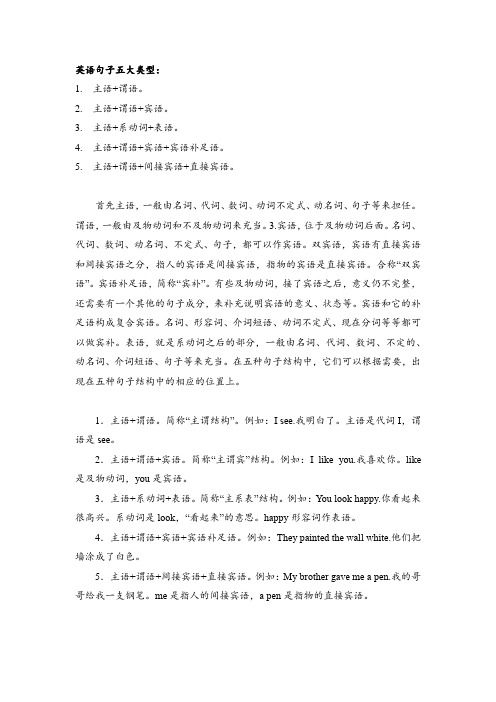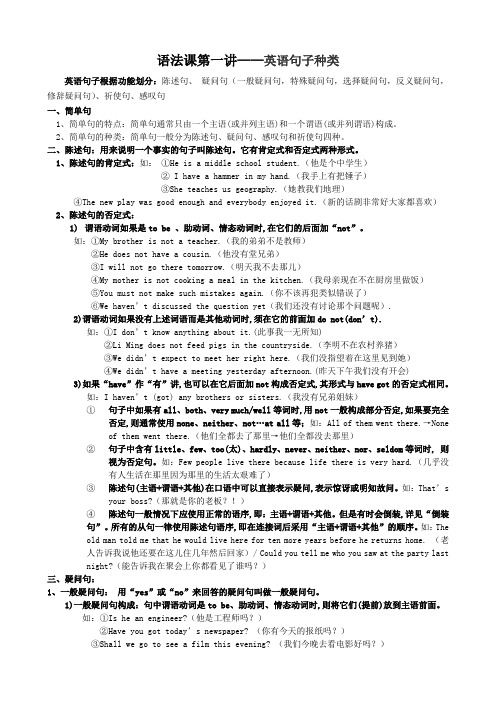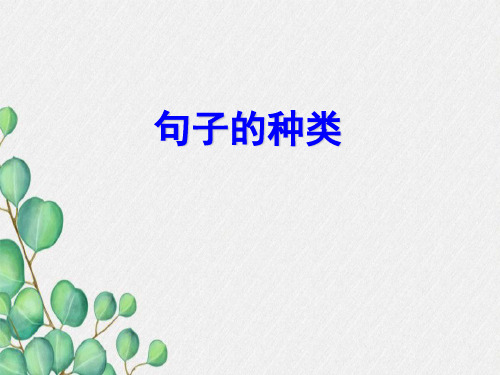英语基础知识之句子种类
- 格式:doc
- 大小:40.50 KB
- 文档页数:3


英语句子五大类型:1.主语+谓语。
2.主语+谓语+宾语。
3.主语+系动词+表语。
4.主语+谓语+宾语+宾语补足语。
5.主语+谓语+间接宾语+直接宾语。
首先主语,一般由名词、代词、数词、动词不定式、动名词、句子等来担任。
谓语,一般由及物动词和不及物动词来充当。
3.宾语,位于及物动词后面。
名词、代词、数词、动名词、不定式、句子,都可以作宾语。
双宾语,宾语有直接宾语和间接宾语之分,指人的宾语是间接宾语,指物的宾语是直接宾语。
合称“双宾语”。
宾语补足语,简称“宾补”。
有些及物动词,接了宾语之后,意义仍不完整,还需要有一个其他的句子成分,来补充说明宾语的意义、状态等。
宾语和它的补足语构成复合宾语。
名词、形容词、介词短语、动词不定式、现在分词等等都可以做宾补。
表语,就是系动词之后的部分,一般由名词、代词、数词、不定的、动名词、介词短语、句子等来充当。
在五种句子结构中,它们可以根据需要,出现在五种句子结构中的相应的位置上。
1.主语+谓语。
简称“主谓结构”。
例如:I see.我明白了。
主语是代词I,谓语是see。
2.主语+谓语+宾语。
简称“主谓宾”结构。
例如:I like you.我喜欢你。
like 是及物动词,you是宾语。
3.主语+系动词+表语。
简称“主系表”结构。
例如:You look happy.你看起来很高兴。
系动词是look,“看起来”的意思。
happy形容词作表语。
4.主语+谓语+宾语+宾语补足语。
例如:They painted the wall white.他们把墙涂成了白色。
5.主语+谓语+间接宾语+直接宾语。
例如:My brother gave me a pen.我的哥哥给我一支钢笔。
me是指人的间接宾语,a pen是指物的直接宾语。

三句子的种类句子是一个独立的语言单位,表示一个完整的思想.按使用目的可分为陈述句、感叹句、疑问句和祈使句;从结构上又可分为简单句、并列句和复合句.按使用目的分:一、陈述句That boy always helps others.Tom was not at home yesterday.He is too late to catch the bus.二、疑问句一般疑问句、特殊疑问句、选择疑问句和反意疑问句Are you a doctorHow often do you have an English partyWhich would you like better, tea or coffeeShe is too young to go to school, is she三、感叹句(一)What +a /an+形容词+可数名词的单数形式+主语+谓语 ==二How+形容词+a/an +可数名词的单数形式+主语+谓语What a beautiful girl she is == How beautiful a girl she is三 What+形容词+可数名词的复数+主语+谓语What beautiful girls they are(四)What+形容词+不可数名词+主语+谓语What fine weather it is(五)How+形容词或副词+主语+谓语How interesting the dog is(六)How+主语+谓语How time flies四、祈使句祈使句主语通常被省略,谓语动词用原型.Be quietDon’t be late从结构上分:一、简单句句子只包含一个主谓结构.如,五种基本句型列式如下:基本句型一:主+系+表基本句型二:主+谓基本句型三:主+谓+宾基本句型四:主+谓+间宾+直宾基本句型五主+谓+宾+宾补.二、并列句句子包含两个或多个主谓结构,通常有并列连词连结.由并列连词把两个或两个以上的简单句连在一起的句子叫并列句.不同的并列连词表示并列分句之间的不同关系.根据并列分句之间的关系不同,并列句可以分为以下几种: 1.表示联合关系的并列句这类并列句常用并列连词and 和,not only ... but also... 不但……而且……等来连接,这时分句之间是顺承关系或并列关系.and一般不译出来.1. We bought her a birthday present,_____ she liked it very much.A. soB. orC. andD. but2. — Didn’t you give roses to your father on Father’s Day— Oh, not only my father,_____ my grandpa got red roses.A. orB. andC. butD. until2.表示转折关系的并列句这类并列句常用but 但是;可是,yet可是;然而,while 而等来连接,后面分句与前面分句之间有意义上的转折关系.1. — Would you like to go to the concert with me— I’d love to,_____ I can’t. I have a lot of homework to do.A. orB. butC. soD. and2. The doctors tried their best to save the patient’s life,_____ failedA. orB. soC. butD. because3.表示选择关系的并列句这类并列句常用并列连词or或者,either …or …要么……,要么……等连接.1. _____ Lily _____ Lucy may go with you because one of them must stay at home.A. Not only; but alsoB. Neither; norC. Both; andD. Either; or2. None of the shoes in the shops are the right size. They are _____ too big _____ too small.A. both; andB. neither; norC. either; orD. not only; but also3. “Are you going to eat here ____ take it away” asked the waiter..A. andB. soC. orD. but.4.表示因果关系的并列句这类并列句常用并列连词so因此;所以,for 因为等连接,后面分句与前面分句之间有因果关系.1. Mother was ill,_____ Father cooked for us instead.A. butB. orC. soD. and2. There is a lot of traffic in this city,_____ look both waysbefore crossing the streetA. soB. andC. butD. for特殊的并列句1.祈使句+and+一般将来时的句子这个句型表示“如果做到了祈使句表示的事情,就会有后面句子表示的结果”.2.例如: Study hard,_____ you are sure to have a good resultin the exam.A. orB. andC. forD. but3. 2. 祈使句 + or + 一般将来时的句子这个句型表示“如果做不到祈使句表示的事情,就会有后面句子表示的结果”4.例如: 1. Be quick,_____ we’ll be late for class.A. orB. soC. andD. but2. Come a little earlier next time,_____ you’ll miss thebest part of the TV play.A. andB. butC. orD. till三、复合句复合句Complex Sentence由一个主句Principal Clause和一个或一个以上的从句Subordinate Clause构成. 主句是全句的主体,通常可以独立存在;从句则是一个句子成分,不能独立存在.从句不能单独成句,但它也有主语部分和谓语部分,就像一个句子一样.所不同在于,从句须由一个关联词引导. 我们至今学过的从句有:定语从句, 名词性从句主语从句、宾语从句、表语从句、同位语从句,和状语从句.1. 定语从句 He is the man who wants to see you.2. 同位语从句 She told us her hope that she would become a pianist.注意:定语和同位语从句的区别.3. 表语从句 This is what we should do4. 宾语从句注意it做形式宾语Everybody knows that money doesn't grow on treesWe think it wrong that he told a lie to everyone. it做形式宾语5.主语从句注意it做形式主语What caused the accident remains unknownIt is certain that he will win the matchit做形式主语6.状语从句MyfriendsdislikemebecauseI’mhandsomeandsuccessfu l.。

英语基础知识之句子种类英语基础知识之句子种类1.简单句: 只有一个主谓结构的句子。
2.并列句: 由并列连词把两个或两个以上的简单句连在一起构成。
3.复合句: 复合句= 主句+ 从句(主句是一个完整的句子,可以独立存在。
从句是一个不完整的句子,必须和一个主句连用,不能独立存在。
)◆简单句:只有一个主语(或并列主语)和一个谓语(或并列谓语)。
简单句的五种基本句型(1) 主语+不及物动词He laughed.(2) 主语+连系动词+表语The weather is very cold.(3) 主语+及物动词+宾语W e like English.(4) 主语+及物动词+双宾语(间接宾语+直接宾语)She taught them English.(5) 主语+及物动词+宾语+宾语补足语The sun keeps us warm.请说出下列句子类型:1.Summer is coming.2.They won’t let me go.3.He showed me a new TV set.4.She knows what to do.5.The weather is very cold.◆并列句: 由并列连词(and, but, or等)或分号(;)把两个或两个以上的简单句连在一起构成。
1.I turned on the TV. I watched it.I turned on the TV and watched it.2.I bought my sister a present. She didn’t lik e it.I bought my sister a present, but he didn’t like it.常用并列连词平行并列连词: and, both…and, not only… but also, neither…nor转折并列连词:but, however, while, yet因果并列连词: for, so选择并列连词: or, either…orI like swimming, but he doesn’t.W e must hurry or we’ll be late.I couldn’t find you so I left.It must have rained last night, for the ground is wet.请用合适的并列连词把每组句子合并为一个并列句。

语法课第一讲——英语句子种类英语句子根据功能划分:陈述句、疑问句(一般疑问句,特殊疑问句,选择疑问句,反义疑问句,修辞疑问句)、祈使句、感叹句一、简单句1、简单句的特点:简单句通常只由一个主语(或并列主语)和一个谓语(或并列谓语)构成。
2、简单句的种类:简单句一般分为陈述句、疑问句、感叹句和祈使句四种。
二、陈述句:用来说明一个事实的句子叫陈述句。
它有肯定式和否定式两种形式。
1、陈述句的肯定式:如:①He is a middle school student.(他是个中学生)② I have a hammer in my hand.(我手上有把锤子)③She teaches us geography.(她教我们地理)④The new play was good enough and everybody enjoyed it.(新的话剧非常好大家都喜欢)2、陈述句的否定式:1)谓语动词如果是to be 、助动词、情态动词时,在它们的后面加“not”。
如:①My brother is not a teacher.(我的弟弟不是教师)②He does not have a cousin.(他没有堂兄弟)③I will not go there tomorrow.(明天我不去那儿)④My mother is not cooking a meal in the kitchen.(我母亲现在不在厨房里做饭)⑤You must not make such mistakes again.(你不该再犯类似错误了)⑥We haven’t discussed the question yet(我们还没有讨论那个问题呢).2)谓语动词如果没有上述词语而是其他动词时,须在它的前面加do not(don’t).如:①I don’t know anything about it.(此事我一无所知)②Li Ming does not feed pigs in the countryside.(李明不在农村养猪)③We didn’t expect to meet her right here.(我们没指望着在这里见到她)④We didn’t have a meeting yesterday afternoon.(昨天下午我们没有开会)3)如果“have”作“有”讲,也可以在它后面加not构成否定式,其形式与have got的否定式相同。

英语中的句子种类陈述句,疑问句,祈使句,感叹句(划分标准:语气)一. 陈述句1. 定义:陈述句是用于陈述一个事实或表达说话人的看法的句子。
陈述句主要分为肯定句和否定句。
2. 陈述句的肯定句式主要有五种基本句型(1)“主语+系动词+表语”I am honored. 我很荣幸。
(2)“主语+不及物动词(谓语)”The students work very hard.学生们学习很努力。
(3)“主语+及物动词(谓语)+宾语”I teach English. 我教英语。
(4)“主语+及物动词(谓语)+间接宾语+直接宾语”,间接宾语是人,直接宾语是物。
能接双宾语的动词多数要在间接宾语前加to或for。
①加to的动词有give, send, pass, take, bring, show, lend, sell等。
She sent me a present.=She sent a present to me.她寄给了我一份礼物。
②加for的动词有buy, make, build, mend, cook等。
My father bought me a bike.=My father bought a bike for me. 我爸爸给我买了一辆自行车。
(5)“主语+及物动词(谓语)+宾语+宾语补足语”The teacher asked the students to listen carefully in class. 老师要求学生上课认真听讲。
3.陈述句的否定句式(1)be动词+not(2)情态动词/助动词+not+动词原形I don't get up at six o'clock this morning.今天早上六点我没有起床。
(3)no, never, har dly, seldom, few, little, nobody, neither…nor, none 等词构成否定句。
I can hardly believe his story.我几乎不相信他的故事。
句子的种类英语基础语法汇总句子的类型句子可以从不同的角度进行分类。
按照句子的语气,句子可分为陈述句、祈使句、感叹句、疑问句四种,一般称为句类。
以下是小编整理的句子的种类英语基础语法汇总,希望大家喜欢。
(一)按使用目的可分为陈述句、疑问句、祈使句和感叹句。
1) 陈述句(Declarative Sentences):说明一个事实或陈述一种看法。
Light travels faster than sound. 光比声速度快。
(说明事实)The film is rather boring. 这部电影很乏味。
(说明看法)2) 疑问句(Interrogative Sentences):提出问题。
有以下四种:a. 一般疑问句(General Questions):Can you finish the work in time?你能按时完成工作吗?b. 特殊疑问句(W Questions; H Questions):Where do you live? 你住那儿?How do you know that? 你怎么知道那件事?c. 选择疑问句(Alternative Questions):Do you want tea or coffee?你是要茶还是要咖啡?d. 反意疑问句(Tag-Questions):He doesn't know her, does he?他不认识她,对不对?3) 祈使句(Imperative Sentences):提出请求,建议或发出命令,例如:Sit down, please. 请坐。
Don't be nervous! 别紧张!4) 感叹句(Exclamatory Sentences):表示说话人惊奇、喜悦、愤怒等情绪,例如:What good news it is! 多好的消息啊!(二)句子按其结构可以分为以下三类:1) 简单句(Simple Sentences):只包含一个主谓结构句子叫简单句,例如:She is fond of collecting stamps. 她喜欢集邮。
高考英语语法基础---句子种类分类一.句子种类(按照用途分类)1.陈述句2.祈使句3.感叹句4.疑问句(一般疑问句,特殊疑问句,选择疑问句,反意疑问句。
)具体知识:1.陈述句陈述句(Declarative Sentence)是陈述一个事实或者说话人的看法。
它包括肯定句(The Affirmative Sentence)和否定句(The Negative Sentence)两种。
陈述句在书写时句末用句号,在朗读时用降调。
陈述句的五种基本句型:(1) 主语+连系动词+表语(2) 主语+谓语(不及物动词)(3) 主语+谓语(及物动词)+宾语(4) 主语+谓语(及物动词)+间接宾语+直接宾语(5) 主语+谓语(及物动词)+宾语+宾语补足语My uncle tells me that the key to his success is honesty.2. 祈使句祈使句常常是表达说话人对对方的劝告、叮嘱、请求或命令等。
因此,祈使句中一般没有主语,但根据其句意,实际上是省略了主语you。
祈使句句末用感叹号或句号,朗读时,常用降调。
在表达请求或劝告时,在祈使句前或句末可加上please,以使句子的语气更加缓和或客气。
祈使句一般没有时态的变化,也不能与情态动词连用。
Keep off the grass! 勿踩踏草地!Always keep in mind that your main task is to get this company running smoothly.3. 感叹句感叹句的基本构成形式1).What(+a/an)+形容词+名词+主语+谓语!2).How+形容词+a/an+可数名词单数+主语+谓语!3).How+形容词/副词+主语+谓语!You can't imagine how crucial a role the pigeons played in the battlefields.你无法想象在过去的战场山鸽子发挥了多么重要的作用。
英语基础知识之句子种类
1.简单句: 只有一个主谓结构的句子。
2.并列句: 由并列连词把两个或两个以上的简单句连在一起构成。
3.复合句: 复合句= 主句+ 从句
(主句是一个完整的句子,可以独立存在。
从句是一个不完整的句子,必须和一个主句连用,不能独立存在。
)
◆简单句:只有一个主语(或并列主语)和一个谓语(或并列谓语)。
简单句的五种基本句型
(1) 主语+不及物动词
He laughed.
(2) 主语+连系动词+表语
The weather is very cold.
(3) 主语+及物动词+宾语
W e like English.
(4) 主语+及物动词+双宾语(间接宾语+直接宾语)
She taught them English.
(5) 主语+及物动词+宾语+宾语补足语
The sun keeps us warm.
请说出下列句子类型:
1.Summer is coming.
2.They won’t let me go.
3.He showed me a new TV set.
4.She knows what to do.
5.The weather is very cold.
◆并列句: 由并列连词(and, but, or等)或分号(;)把两个或两个以上的简单句
连在一起构成。
1.I turned on the TV. I watched it.
I turned on the TV and watched it.
2.I bought my sister a present. She didn’t like it.
I bought my sister a present, but he didn’t like it.
常用并列连词
•平行并列连词: and, both…and, not only… but also, neither…nor
•转折并列连词:but, however, while, yet
•因果并列连词: for, so
•选择并列连词: or, either…or
I like swimming, but he doesn’t.
W e must hurry or we’ll be late.
I couldn’t find you so I left.
It must have rained last night, for the ground is wet.
请用合适的并列连词把每组句子合并为一个并列句。
1.He was tired. He went to bed.
2.The child hid behind his mother's skirt. He was afraid of the dog.
3.He made a promise. He didn’t keep it.
复合句:
在复合句中,主要包含以下类型从句:
1.主语从句
2.宾语从句
3.表语从句
4.同位语从句
5.状语从句
6.定语从句
主语从句What you said is wrong.
宾语从句I don’t know when he’ll leave.
表语从句This is where he put his books.
同位语从句The fact that there are no lives on the moon is known to us all. 时间状语从句When I came in, he was reading.
地点状语从句Please put the book where it was.
原因状语从句He was absent because he was ill.
条件状语从句I’ll be back his evening unless it rain.
让步状语从句Though he is young, he knows a lot of things.
目的状语从句I got up early so that I could catch the first bus.
结果状语从句Mary is so busy that she can hardly afford time for holidays.
比较状语从句He is taller than I am.
方式状语从句Do as I say and sit down.
定语从句This is the house where we once lived.
指出下列各从句的类型:
I hope that everything is all right.
That you are leaving is a pity.
China is no longer what she used to be.
The teacher sugggested that we should carry out the plan as quickly as possible. My suggestion is that we (should) start early tomorrow.
He asked me the question whether he could leave at five.
Who will stay makes no difference.
The question remains whether they will be able to help us.
They were all very much worried over the fact that you were sick.
He made a promise that he would come to see me if he was free.
When you cross a main road, you must be careful.
Put it where you found it.
I eat ice-cream so much because I like sweet food.
Since you won't help me, I'll ask someone else.
If it snows tomorrow, we will build a snowman.
Y ou'll be late, unless you hurry.
He acts as if/as though he were the owner.
Although you feel very ill right now, this is still a common disease.
She was so frightened about the dog that she cried.
Beijing is the place where (in which) I was born.
Please pass me the book whose cover is green.
判断下列句子是简单句、并列句还是复合句:
1. W e often study Chinese history on Friday afternoon.
2. The boy who offered me his seat is called Tom.
3. There is a chair in this room, isn’t there?
4. My brother and I go to school at half past seven in the morning and come back home at seven in the evening.
5. He is in Class One and I am in Class Two.
6. He was fond of drawing when he was yet a child.
7. Neither has he changed his mind, nor will he do so.
8. What he said at the meeting is very important, isn’t it?
9. The farmer is showing the boy how to plant a tree.
10. Both Tom and Jack enjoy country musi。